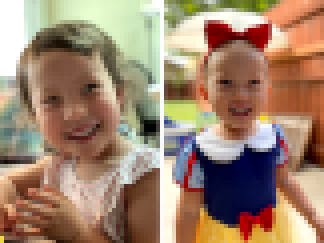Content Warning: pregnancy loss/stillbirth.
I sent this meme out to the faculty at my high school in May with an invitation to meet with me and reflect on this past year of teaching. I am an instructional coach and I teach emerging multilingual learners, but I also consider myself a practicing unlicensed teacher-therapist. Is that a thing? It should be a thing.

The conversations I’ve had this year with educators got real deep, real fast. For many of the teachers I’ve spoken with, this has been the most difficult year of their careers. Teachers have broken down in my office sharing that this year, they felt like failures, they felt like first year teachers all over again and that this year, they contemplated leaving the profession. And in a heart-breaking exchange I had with a colleague and friend who has been teaching for 18 years, she told me that she can no longer bend over backwards for a system that doesn’t care if she breaks in half. This is not just the case for my school, my district or even my state. There has been a collective struggle among teachers across the country.
When I talk to my colleagues, we reflect on why we became educators in the first place, why we’re still doing it and what we can do to make the educational system better. In this time of demoralization, burnout with quality educators leaving the profession, where do we look for answers to the very real, complex problems that we face?
A good starting place is understanding trauma. Here’s what I find so compelling about trauma research, there is something about traumatic events and grief that shatters our carefully crafted constructs about the world. Trauma has a way of forcing us to look honestly at what is not working in our lives—what is unsustainable—and recognizing change as an immediate need. That was certainly true for me when I experienced my own trauma.
In August of 2015, I was 37½ weeks pregnant with my first child. One Saturday morning, I couldn’t feel my baby move. I waited for a kick or a shift of movement that never came. The subsequent nightmare of induced labor, delivery, waiting and managing the painful disconnect between what I knew had happened and my body’s response to having a baby is difficult for me to talk any more about, even now. In the end, we never got an answer from the doctors. The best explanation medical science had to offer us was, “You and your baby were perfectly healthy. It may have been a cord accident.”
Read more how this trauma has shaped my teaching here.
For a long time, I adamantly refused to think of that experience as a “trauma” because I believed the only people who could legitimately use that word were war veterans or victims of violence and abuse, but, eventually, after some work with a grief counselor, I understood that I was suffering from PTSD as a result of the stillbirth of my first child. When I became pregnant again, I met regularly with a therapist who helped me manage the effects of my past trauma. I was anxious all the time and I was convinced that I would lose this baby too. Fortunately, I did not.

But when the worst thing you can imagine happens, there is no longer a reason to believe that all kinds of horrible things can’t happen again and again. Catastrophic thinking became my norm, and even now, when it comes to my kids, it’s difficult for me not to fall into worst-case scenario thinking. So, when I dropped off my daughter at school the day after the Uvalde shooting, I sobbed in my car. Yes, statistically, school shootings are very rare, but here’s the thing about trauma: Trauma rewires your brain. Even now, years later, I can no longer engage in statistical thinking. Even when it’s highly unlikely that something bad will happen, statistics and probability don’t have the same effect on me that they once did. My worst case scenario actually happened to me, even though I was told it was rare.
You know what is not rare? Trauma. We have experienced collective trauma over the past two years. Big T trauma and little t trauma—it affects us all, students and educators, and it impacts learning.
Now is not the time to dismiss the hardship of the last two and a half years and say, “Kids are resilient. Teachers are resilient. We have overcome the pandemic and fought our way back to normalcy and we need to keep fighting with grit and determination.” We don’t need to “overcome.” We don’t need “normalcy.” We cannot go back to playing the same game with different educational buzzwords. We don’t need to minimize trauma or glorify it. What we need is post-traumatic wisdom.
Dr. Bruce Perry, co-author of, “What Happened to You? Conversations on trauma, resilience, and healing,” defines post-traumatic wisdom as “the experience where you've been able to get through adversity, and you're now at a safe place in your life and can look back and reflect and take what you've learned and use that to see the world differently. You use your pain and transform it to power and help other people.”
When I left the classroom to become an instructional coach, I was explicitly tasked with helping teachers support their English learners. Those first couple of years, I felt ineffective. I didn’t see the kind of changes in instructional practices that I wanted for my school and for our students.
After my personal experience with trauma, my job as an instructional coach took on another dimension—empathy. I began to see everyone I interacted with as a human being with history, knowledge and expertise I had never noticed before. Post-traumatic wisdom gave me eyes to see it.
In addition to my coaching duties, I went back into the classroom and taught my students about self-compassion and mindfulness, two strategies that rescued my sanity repeatedly during my second pregnancy. I looked at the teachers I worked with as humans first—not just as practitioners I needed to equip with specific tools. I realized that to change practices at our school, we needed to change our beliefs and mindsets. I came to this new perspective because the relationships I had at work and in my personal life provided me the kind of safe spaces Dr. Bruce Perry was talking about—the safe spaces needed to heal, reflect and develop post- traumatic wisdom.
That’s what education needs right now. We need safe places to do some deep reflection and we need to transform our pain into power. The entire educational system can’t rely on individual educator grit, it’s collective post-traumatic wisdom that can lead to change.
Trauma research commonly refers to stress responses that can emerge after a traumatic event. We’ve probably all heard of the common stress responses of “fight” or “flight,” which refer to the reflex of fleeing danger or fighting it. But there are others too. I recently learned about two other responses, “freeze,” which is when someone pauses to better understand a situation to assess whether there is a threat and “flock,” which is a process when individuals who experience shared and persistent burdens connect and mobilize to support one another.
Flocking caught my attention. It speaks to the kind of connections and authentic relationships that should make up every school, every district. I think our post-traumatic wisdom needs to start with the flock.
If shows like "The Office" have taught us anything it is that any workplace has its aggravations and stressors. What makes us stay is the relationships, but hope is in the flock. It’s the stress response of flocking that can help us develop post-traumatic wisdom, so an important question for educators to ask is, “what would it look like for my professional community to flock?”
Flocking can start with simply affirming each other’s experiences. It’s a natural instinct to turn to each other during periods of stress. It’s getting an email from a parent that is rude and demanding in tone and sending a screenshot of that to your teacher bestie saying, “This is out-of-line, right?” and getting a response back saying, “Yes, that is totally uncalled for!” Flocking is when you forward that same email to your admin and your admin has the self-awareness and emotional intelligence to say, “I’m sorry you got that email. Let’s talk about the best way to respond.”
My friend, who is a special education teacher, recently reached out to tell me that, after a difficult year, she considered leaving the profession. She asked her administrators for more planning time and they listened. They gave her the time she needed to do her job. Flocking might look like all the special education teachers in the district going to district leaders to say, “We need more planning time to manage our caseload of students.” Flocking is this act of finding affirmation, and then turning that affirmation into collective power to create change.

One night after hours of giving students feedback on papers late into the night after putting our children to bed, which is always a lengthy process, my husband, who is also a teacher, said to me, “The thing is, I feel like I know what my students need, I just don’t have the capacity to give it to them.” Of course he couldn’t. You cannot give what you do not have.
We have all been there. At one point, we’ve all said to ourselves, “If I could just manage my time better. If I could just set up better systems in my classroom. If I just stay awake and send out these emails tonight.” It is unhealthy to constantly push yourself to operate at the extreme ends of your capacity all the time, it is unsustainable to feel like you must do this in order to cope with the stress of being a teacher and it is doubly wrong to believe that this is the only way to be a “good teacher.”
I don’t want to help fellow educators cope anymore. I want them to resist.
I want to give them permission to reject the narrative that if you just try harder, you can do the impossible. I want to help them acknowledge the trauma that they might be living through or that their students or colleagues are experiencing, to find safe spaces to heal and reflect, to give themselves some compassion—and then, to flock.
I want to help fellow educators understand that we can flock together to demand the conditions we need to meet the needs of our students and staff and that if we are told that the system doesn’t allow for that, we need to change the system.
Instead of trying to cope, we can resist and resist together. And sometimes, there is joy in resistance—in believing that we can change the way things are and that we can model that for our students.
When we flock, we affirm each other's experiences, we share resources, and we resist together. We lost an amazing educator last year, bell hooks, who wrote, “one of the most vital ways we sustain ourselves is by building communities of resistance, places where we know we are not alone.”
My hope is that every educator finds that kind of community of resistance when they need it. It’s that flocking and that post-traumatic wisdom that we need to bring with us into our classrooms every day. We need to teach like we understand that we have all been through some shit, because we have.
Our post-traumatic wisdom can help us heal together and address the traumas of the past couple of years by acknowledging what wasn’t working before and will certainly not work now—not simply cope with it, but resist together to create change.


